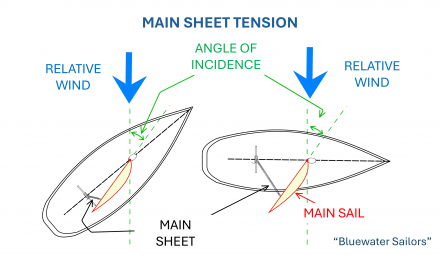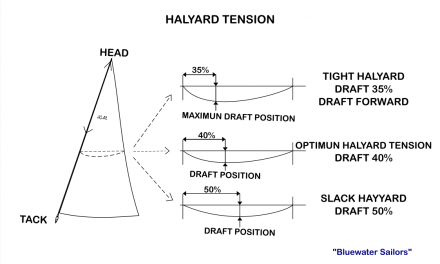Introduction.
In the previous chapter, “Foresails (I): Control Elements,” we saw how to use these controls (stay tension, halyard tension, sheet car position, and sheet tension) in different wind conditions.
In this new chapter, which complements the previous one, we’ll take a practical look at how to use the visual indicators on this sail, the “telltales” which are our best instrument for fine-tuning the trim when sailing upwind or with the relative wind to the bow of the beam (with the relative wind aft of the beam, the telltales are irrelevant).
Normally, a genoa (or jib) has three pairs of telltales: one at the bottom of the sail, another in the middle, and the last at the top. The telltales on the port side of the sail are usually red, and those on the starboard side are green. In this chapter, we will refer to the telltales according to whether they are located on the windward (WIND) or leeward (LEA) side of the sail.
When the telltales are parallel and horizontal, the airflow on both sides of the sail is aligned and the sail is properly trimmed. When one of the telltales flaps, it is time to act on the control elements or change course to regain proper trim.
Trimming sequence.
Although it’s not necessary to establish a fixed trimming sequence, in this chapter we’ll follow a few simple steps, trying to make them easy to understand. We’ll act sequentially on the different control elements. Later, sailing experience and observation will do the rest, and sail trimming will become more intuitive.
We’ll start from an initial situation in which we’ve hoisted the headsail with the neutral positions (or tensions) of the forestay, halyard, and sheet car, as we saw in the previous chapter, for moderate winds; that is, the usual way we hoist our sails.
From this situation, the order we’ll follow is as follows:
– In the first phase of trimming, we will act only on the genoa (or jib) sheet, trimming it in view of the telltales and the desired course. We will cover this in section a) Telltales and Sheet Tension.
– If it hasn’t been possible to have all the telltales by simply trimming the sheet, then we will act on the position of the sheet car in view of the telltales to modify the sail’s twist. We will explain these actions in section b) Telltales and Sheet Car Position.
– With these actions, the sail should normally be trimmed, but if we haven’t achieved this, we can check the forestay tension; we will explain this in section c) Telltales and Forestay Tension.
– Finally, we will review some tips in section d) Halyard Tension on the Headsail.
a) Telltales and sheet tension.
Este contenido solo está disponible para subscriptores de navegantesoceanicos.com
Efecúe Log In para desbloquear.






